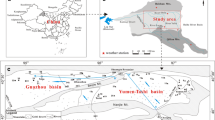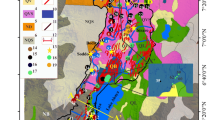Abstract
This paper reports our work on the strontium hydrogeochemistry of thermal groundwaters in the Baikal Rift System (BRS) in Russia and Mongolia and the Xinzhou basin of the Shanxi Rift System (SRS) in northern China. Though similar in geological background, groundwaters from the BRS and the Xinzhou basin have different strontium isotope compositions. Both the strontium contents and the87Sr/86Sr ratios of thermal water samples from Xinzhou are higher than those of most samples from Baikal. The major reason is the difference in hostrock geochemistry. The hostrocks of the Xinzhou waters are Archaean metamorphic rocks, while those of the Baikal waters except the Kejielikov spring are Proterozoic or younger rocks. In the study areas, cold groundwaters usually show lower87Sr/86Sr ratio due to shorter water-rock interaction history and lower equilibration degree. Strontium hydrogeochemistry often provides important information about mixing processes. Ca/Sr ratio can be used as an important hydrogeochemical parameter. Case studies at Xinzhou show that thermal waters with lowest Ca/Sr ratios are most weakly affected by mixing with shallow groundwaters, as supported by our hydrochemical and sulfur isotope studies.
Similar content being viewed by others
References
Plusnin, G. C., Genesis of hydrothermal fluids of the Baikal Rift Zone using isotopic data, (in Russian with English abstract), Geochemistry, 1978, 9: 481–487.
Chaudhuri, S., Clauer, N., Strontium isotope compositions and potassium and rubidium contents of formation water in sedimentary basins: Clues to the origin of the solutes, Geochimica et Cosmochimica Acta, 1993, 57: 429–437.
Lyons, W. B., The use of strontium isotopes in determining groundwater mixing and brine fingering in a playa spring zone, Lake Terrell, Australia, Journal of Hydrology, 1995, 167: 225–239.
Johnson, T. M., DePaolo, D. J., Rapid exchange effects in isotope ratios in groundwater systems, Water Resources Research, 1997, 33: 187–195.
Pampura, V. D., Sandimirova, G. P., Geochemistry and strontium isotope composition in hydrothermal systems, Novosiberiask: Nauka (in Russian), 1991.
Elderfield, H., Greaves, M., Strontium isotope geochemistry of Icelandic geothermal systems and implications for sea-water chemistry. Geochimica et Cosmochimica Acta, 1981, 45: 2201–2212.
Wang, Y., Shpeyzer, G. M., Hydrogeochemistry of mineral waters from rift systems on the east Asia continent: case studies in Shanxi and Baikal (in Chinese with English abstract), China Environmental Science Press, 2000.
Mazor E., Drever, J. I., Finley, J., et al., Hydrochemical implications of groundwater mixing: an example from the southern Laramie Basin, Wyomin, Water Resources Research, 1993, 29: 193–205.
Author information
Authors and Affiliations
Corresponding author
Rights and permissions
About this article
Cite this article
Wang, Y., Shen, Z. & Moisevich, S.G. Strontium hydrogeochemistry of thermal groundwaters from Baikal and Xinzhou. Sci. China Ser. E-Technol. Sci. 44 (Suppl 1), 138–143 (2001). https://doi.org/10.1007/BF02916805
Received:
Issue Date:
DOI: https://doi.org/10.1007/BF02916805




